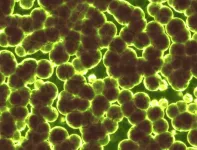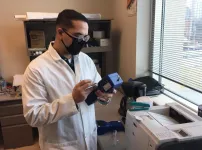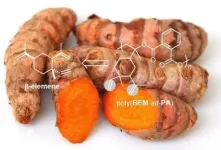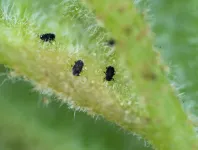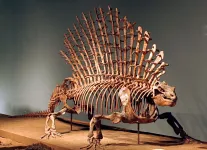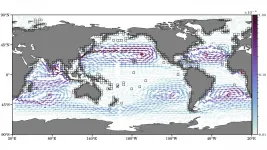Nanoparticle-delivered COVID-19 vaccine candidate shows promise in preclinical studies
New Cleveland Clinic-led research published in mBio
2021-03-02
(Press-News.org) CLEVELAND - Researchers from Cleveland Clinic's Global Center for Pathogen Research & Human Health have developed a promising new COVID-19 vaccine candidate that utilizes nanotechnology and has shown strong efficacy in preclinical disease models.
According to new findings published in mBio, the vaccine produced potent neutralizing antibodies among preclinical models and also prevented infection and disease symptoms in the face of exposure to SARS-CoV-2 (the virus that causes COVID-19). An additional reason for the vaccine candidate's early appeal is that it may be thermostable, which would make it easier to transport and store than currently authorized COVID-19 vaccines.
"Our vaccine candidate delivers antigens to trigger an immune response via nanoparticles engineered from ferritin--a protein found in almost all living organisms," said Jae Jung, PhD, director of the Global Center for Human Health & Pathogen Research and co-senior author on the study. "This protein is an attractive biomaterial for vaccine and drug delivery for many reasons, including that it does not require strict temperature control."
Added Dokyun (Leo) Kim, a graduate student in Dr. Jung's lab and co-first author on the study, "This would dramatically ease shipping and storage constraints, which are challenges we're currently experiencing in national distribution efforts. It would also be beneficial for distribution to developing countries."
Other benefits of the protein nanoparticles include minimizing cellular damage and providing stronger immunity at lower doses than traditional protein subunit vaccines against other viruses, like influenza.
The team's vaccine uses the ferritin nanoparticles to deliver tiny, weakened fragments from the region of the SARS-CoV-2 spike protein that selectively binds to the human entry point for the virus (this fragment is called the receptor-binding domain, or RBD). When the SARS-CoV-2 RBD binds with the human protein called ACE2 (angiotensin-converting enzyme 2), the virus can enter host cells and begin to replicate.
The researchers tested their vaccine candidate on a ferret model of COVID-19, which reflects the human immune response and disease development better than other preclinical models. Dr. Jung, a foremost authority in virology and virus-induced cancers, previously developed the world's first COVID-19 ferret model--a discovery that has significantly advanced research into SARS-CoV-2 infection and transmission.
In this study, the researchers administered an initial dose of the vaccine candidate followed by two booster vaccines given 14 and 28 days later. One group received the vaccines intramuscularly, while another group received them both intramuscularly and intranasally.
After the second booster, all vaccinated models produced strong neutralizing antibodies. This suggests that repeated exposure to the RBD antigen successfully prepared the immune systems to rapidly fight the virus.
A few days after the second booster (31 days after the initial vaccine dose), the researchers exposed the models to high concentrations of SARS-CoV-2. Compared to the placebo group that received adjuvant-only vaccines (adjuvants are added ingredients that help vaccines work better), those that received the RBD-nanoparticle vaccine were better protected from clinical symptoms and lung damage associated with infection. The findings suggest the vaccine candidate helped prevent infection and serious disease.
Combination intramuscular and intranasal immunization showed more potent protective immunity and faster viral clearance than intramuscular immunization alone. Both were significantly more effective than the adjuvant-only vaccine. More research will be important to uncover the mechanisms behind these differential benefits.
While ferritin nanoparticles are well-characterized for their strong temperature and chemical stability, suggesting the RBD-nanoparticle vaccine may also be thermostable, future investigations will be necessary to validate. The researchers aim to confirm these findings in human clinical trials soon.
INFORMATION:
This study was a close collaboration between Dr. Jung and researchers from Chungbuk National University in South Korea--including co-senior author Young Ki Choi, PhD, and co-first author Young-Il Kim, PhD--and was supported in part by the National Institutes of Health.
[Attachments] See images for this press release:

ELSE PRESS RELEASES FROM THIS DATE:
2021-03-02
There's more to taste than flavor. Let ice cream melt, and the next time you take it out of the freezer you'll find its texture icy instead of the smooth, creamy confection you're used to. Though its flavor hasn't changed, most people would agree the dessert is less appetizing.
UC Santa Barbara Professor Craig Montell and postdoctoral fellow Qiaoran Li have published a study in Current Biology providing the first description of how certain animals sense the texture of their food based on grittiness versus smoothness. They found that, in fruit flies, a mechanosensory channel relays this information about a food's texture.
The channel, called TMEM63, is part of ...
2021-03-02
UPTON, NY--Physically confined spaces can make for more efficient chemical reactions, according to recent studies led by scientists from the U.S. Department of Energy's (DOE) Brookhaven National Laboratory. They found that partially covering metal surfaces acting as catalysts, or materials that speed up reactions, with thin films of silica can impact the energies and rates of these reactions. The thin silica forms a two-dimensional (2-D) array of hexagonal-prism-shaped "cages" containing silicon and oxygen atoms.
"These porous silica frameworks are the thickness of only three atoms," explained Samuel Tenney, a chemist in the Interface Science and ...
2021-03-02
AMES, Iowa - Vaccines are an important tool in fighting porcine reproductive and respiratory syndrome (PRRS), but the fast-mutating virus that causes the disease sometimes requires the production of autogenous vaccines tailored to particular variants.
The production of autogenous vaccines depends on the ability of scientists to isolate the virus, but sometimes that's a tricky process. A new study from an Iowa State University researcher shows that a new cell line may offer a better alternative to the cell line most commonly used to isolate the PRRS virus. That could lead to more reliable processes for creating autogenous vaccines, but most autogenous vaccine producers would have to make dramatic changes to their processes ...
2021-03-02
For nearly a century, improvement in human healthcare has depended heavily on the efficiency with which we can treat bacterial diseases. But today, antibiotic resistance--the ability of certain mutant super-bacteria to block out antibiotics--poses a major threat to healthcare, food security, and overall social development worldwide, threatening to upend much of the progress our civilization has achieved.
Scientists are now urgently attempting to tackle this problem from various angles. Professor Yunho Lee at Gwangju Institute of Science and Technology (GIST), Korea, whose contribution is published in the American Chemical Society's Environmental Science and Technology, is looking at it from the point of view of his field of research--wastewater ...
2021-03-02
If you're looking for an indoor space with a low level of particulate air pollution, a commercial airliner flying at cruising altitude may be your best option. A newly reported study of air quality in indoor spaces such as stores, restaurants, offices, public transportation -- and commercial jets -- shows aircraft cabins with the lowest levels of tiny aerosol particles.
Conducted in July 2020, the study included monitoring both the number of particles and their total mass across a broad range of indoor locations, including 19 commercial flights in which measurements took place throughout ...
2021-03-02
Finding innovative and sustainable solutions to our material needs is one of the core objectives of green chemistry. The myriad plastics that envelop our daily life - from mattresses to food and cars - are mostly made from oil-based monomers which are the building blocks of polymers. Therefore, finding bio-based monomers for polymer synthesis is attractive to achieve more sustainable solutions in materials development.
In a paper published in ACS Sustainable Chemistry & Engineering, researchers from the Kleij group present a new route to prepare biobased polyesters with tuneable properties. The researchers ...
2021-03-02
Insects can reprogram plant growth, transforming ordinary plant parts into intricately patterned shelters that are safe havens for feeding and reproduction.
These structures, called galls, have fascinated biologists for centuries. They're crafted by a variety of insects, including some species of aphids, mites, and wasps. And they take on innumerable forms, each specific in shape and size to the insect species that's created it - from knobs to cone-shaped protrusions to long, thin spikes. Some even resemble flowers.
Insects create galls by manipulating the development of plants, but figuring out exactly how they perform this feat "feels like ...
2021-03-02
The backbone is the Swiss Army Knife of mammal locomotion. It can function in all sorts of ways that allows living mammals to have remarkable diversity in their movements. They can run, swim, climb and fly all due, in part, to the extensive reorganization of their vertebral column, which occurred over roughly 320 million years of evolution.
Open any anatomy textbook and you'll find the long-standing hypothesis that the evolution of the mammal backbone, which is uniquely capable of sagittal (up and down) movements, evolved from a backbone that functioned ...
2021-03-02
WASHINGTON, March 2, 2021 -- Tons of plastic debris get released into the ocean every day, and most of it accumulates within the middle of garbage patches, which tend to float on the oceans' surface in the center of each of their regions. The most infamous one, known as the Great Pacific Garbage Patch, is in the North Pacific Ocean.
Researchers in the U.S. and Germany decided to explore which pathways transport debris from the coasts to the middle of the oceans, as well as the relative strengths of different subtropical gyres in the oceans and how they influence long-term accumulation of debris.
In Chaos, from AIP Publishing, Philippe Miron, Francisco Beron-Vera, Luzie Helfmann, and Peter Koltai report creating a Markov chain ...
2021-03-02
What The Study Did: This study investigates emergency department visits for violence-related injuries occurring at home and outside the home in Cardiff, Wales, before and after COVID-19 lockdown measures were instituted in March 2020.
Authors: Jonathan P. Shepherd, Ph.D., Crime and Security Research Institute at Cardiff University in Wales, is the corresponding author.
To access the embargoed study: Visit our For The Media website at this link https://media.jamanetwork.com/
(doi:10.1001/jama.2020.25511)
Editor's Note: Please see the article for additional information, including other authors, author contributions ...
LAST 30 PRESS RELEASES:
[Press-News.org] Nanoparticle-delivered COVID-19 vaccine candidate shows promise in preclinical studies
New Cleveland Clinic-led research published in mBio



